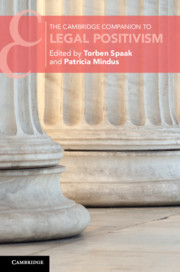Book contents
- The Cambridge Companion to Legal Positivism
- Cambridge Companions to Law
- The Cambridge Companion to Legal Positivism
- Copyright page
- Contents
- Figures
- Contributors
- Acknowledgements
- 1 Introduction
- Part I Fundamentals
- Part II History
- Part III Central Figures
- 9 Jeremy Bentham and the Origins of Legal Positivism
- 10 John Austin
- 11 The Normative Power of the Factual: Georg Jellinek’s Phenomenological Theory of Reflective Legal Positivism
- 12 Hans Kelsen’s Non-Reductive Positivism
- 13 The Legal Positivism of H. L. A. Hart
- 14 From Savigny to Linguistic Analysis: Legal Positivism through Bobbio’s Eyes
- 15 Joseph Raz’s Approach to Legal Positivism
- 16 Bulygin’s Analytical Legal Positivism
- Part IV Main Tenets
- Part V Normativity and Values
- Part VI Critique
- Index
- References
16 - Bulygin’s Analytical Legal Positivism
from Part III - Central Figures
Published online by Cambridge University Press: 21 January 2021
- The Cambridge Companion to Legal Positivism
- Cambridge Companions to Law
- The Cambridge Companion to Legal Positivism
- Copyright page
- Contents
- Figures
- Contributors
- Acknowledgements
- 1 Introduction
- Part I Fundamentals
- Part II History
- Part III Central Figures
- 9 Jeremy Bentham and the Origins of Legal Positivism
- 10 John Austin
- 11 The Normative Power of the Factual: Georg Jellinek’s Phenomenological Theory of Reflective Legal Positivism
- 12 Hans Kelsen’s Non-Reductive Positivism
- 13 The Legal Positivism of H. L. A. Hart
- 14 From Savigny to Linguistic Analysis: Legal Positivism through Bobbio’s Eyes
- 15 Joseph Raz’s Approach to Legal Positivism
- 16 Bulygin’s Analytical Legal Positivism
- Part IV Main Tenets
- Part V Normativity and Values
- Part VI Critique
- Index
- References
Summary
As Redondo explains, Eugenio Bulygin’s legal positivism embraces the separation thesis, a version of the social thesis (which he calls the ‘social sources thesis’), and an indeterminacy thesis, according to which law is sometimes indeterminate, giving judges discretion to decide cases. Bulygin holds that law can be necessarily normative only in a weak, relative sense. Redondo explains that Bulygin espouses two methodological theses that are positivist – that the task of legal philosophers is to explicate legal concepts and that we need to maintain in our legal thinking a distinction between norms and normative propositions – and that he espouses three substantive theses that are also positivist – that legal positivists must adopt a concept of relative normative validity to account for the existence of legal rights and duties, that legal interpretation must proceed on the assumption of linguistic conventionalism and that there is a fundamental and unbridgeable distinction between prescriptive and power-conferring norms. These theses can be said to be positivist because they all, one way or another, enable a value-neutral study of law, i.e. so-called methodological legal positivism.
- Type
- Chapter
- Information
- The Cambridge Companion to Legal Positivism , pp. 371 - 394Publisher: Cambridge University PressPrint publication year: 2021

